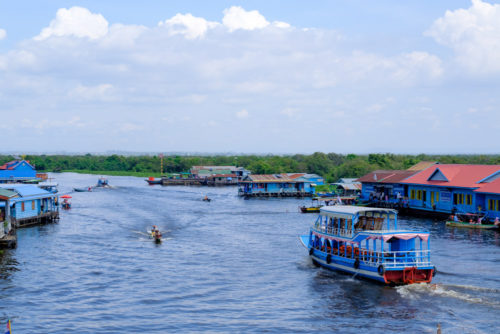
Fourth day on Cambodia we wanted explore places in and around Siem Reap. We planned to visit Tonle Sap Lake for the floating villages, Angkor National Museum and spend the rest of the evening shopping around Siem Reap’s markets.
We started our day with sumptuous complimentary breakfast by our hotel Tanei Boutique. We had a guest in the form of banded bullfrog (Kaloula pulchra) is also known as Asian painted frog, rice frog, or bubble frog. It was busy eating ants crawling on the ground near our breakfast area. I regretted for not carrying macro lens and still managed to get its closeup using my 14mm Fuji.
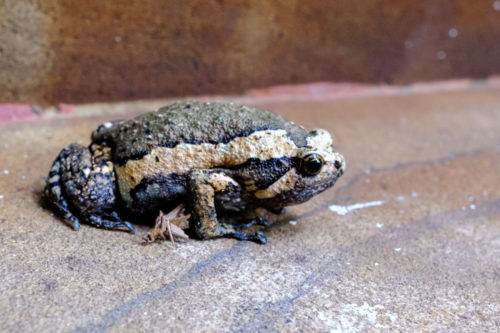
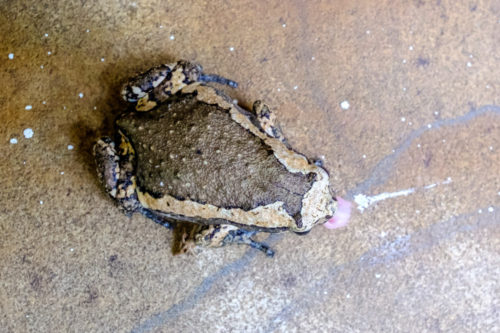
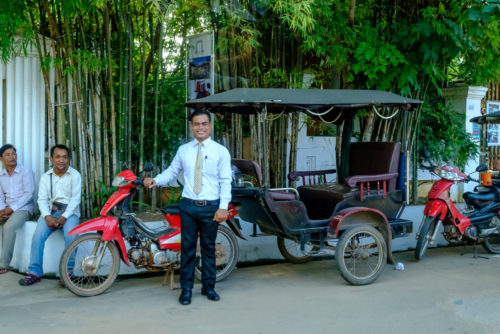
Our hotel had arranged us a 8 seater van to reach Tonle Sap Lake dock. So you can see our Tuk Tuk driver (sitting outside near the gate) seems to have got little disappointed and while the hotel staff in white formal is beaming smile at my camera.
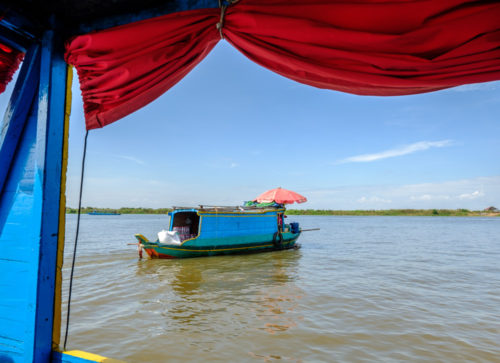
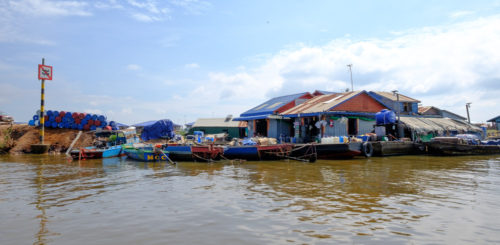
Great Tonle Sap Lake sits only 15 km south of Siem Reap. Tourist guides said that it is a unique eco-system and cultural area offering the opportunity to see a different side of the Siem Reap – floating villages.
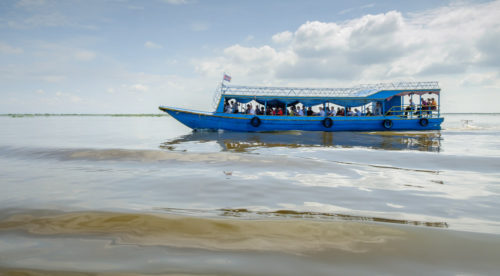
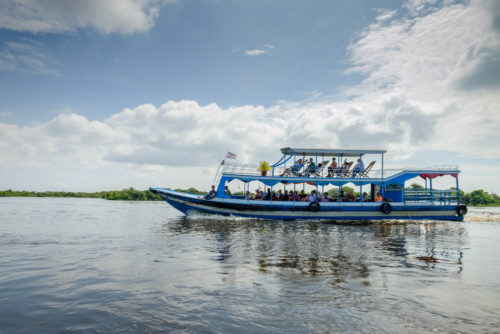
The Tonle Sap Lake is huge body of water stretching across the northwest of the country. In the wet season, the lake is one of the largest freshwater lakes in Asia, swelling to an expansive 12,000 km2. During the dry half of the year it shrinks to as small as 2500 km2, draining into the Tonle Sap River, which meanders southeast, eventually merging with the Mekong River at the ‘Chaktomuk’ confluence at Phnom Penh.
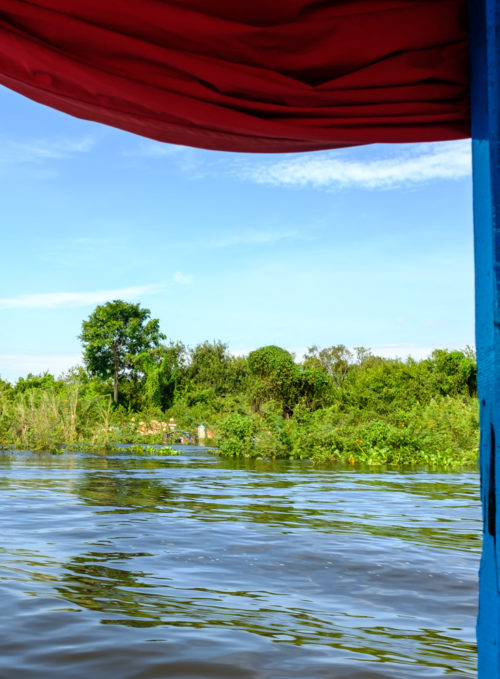
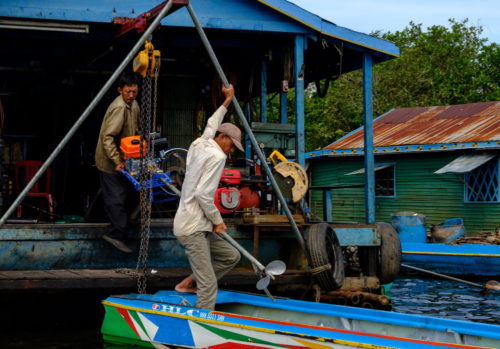
During the wet season a unique hydrologic phenomenon causes the Tonle Sap River to reverse direction, filling the lake. The engine of this phenomenon is the Mekong River, which becomes bloated with snow melt and runoff from the monsoon rains. The swollen Mekong backs up into the Tonle Sap at the point where the rivers meet at Chaktomuk, forcing the waters of the Tonle Sap River back into the lake. The inflow expands the area of lake more than five-fold, inundating the surrounding forested floodplain and supporting an extraordinarily rich and diverse eco-system.
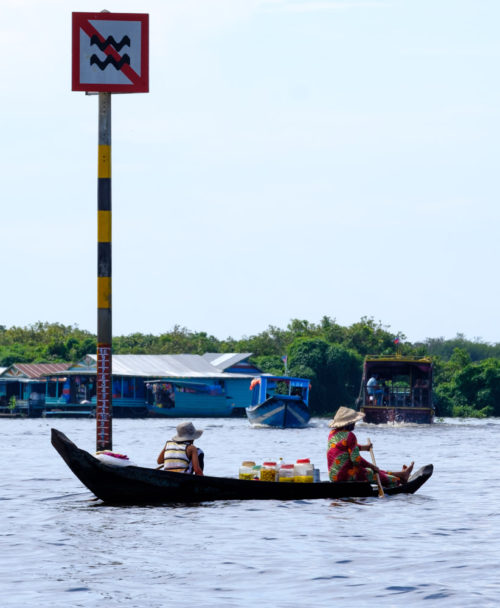
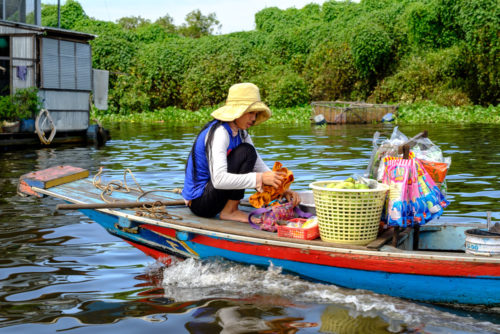
Five provinces circle the area of Tonle Sap Lake, more than three million of population inhabited around the bank of the Lake and 90% of them earn a living by catching fish and making agricultures. Most of the habitation is on floating houses built on top of bamboo or reed piles. They have everything you can dream off in those floating towns. Only way of transport is via boats.
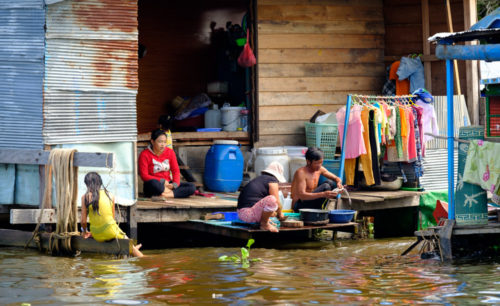
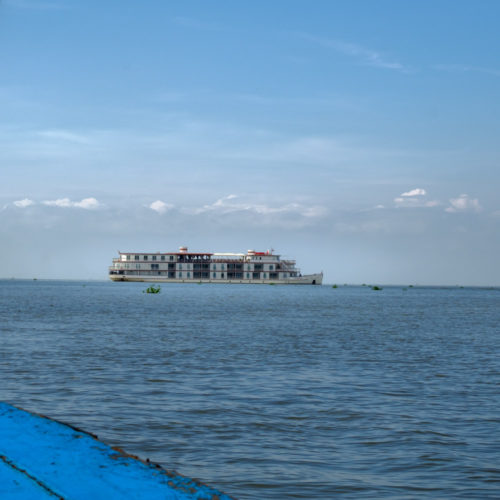
Chong Khneas is the floating village at the edge of the lake closest and most accessible to Siem Reap. If you want a relatively quick and easy look at the Tonle Sap, boat tours of Chong Khneas are available, departing from the Chong Khneas boat docks all day long. Since we did not know the other floating villages, we took a taxi to this place, 11-15km from Siem Reap to the docks where there are always boats waiting for passengers. Boat pricing is variable, traditionally by the boat, but they’ll charge up to $20/per person. We negotiated to 72$ for 6 of us in a single boat. Chong Khneas administration is now owned by a private firm which increased the prices and the area looks more commercial.
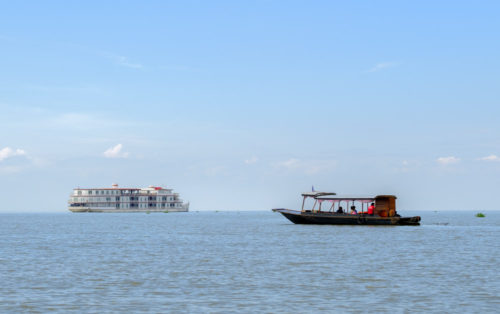
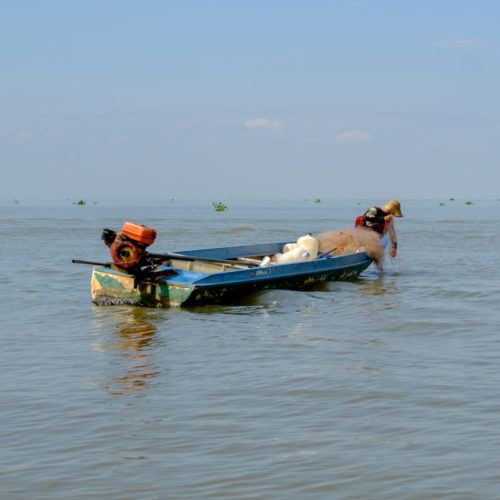
Kampung Phluk and Kampung Khleang are permanent river villages also located on the Tonle Sap lake. However, these villages are much larger than Chong Kneas and are less visited by tourists. I suppose you can get a somewhat more intimate experience with the village and villagers than what we did. I realized that only after coming back from Cambodia. I suggest you to skip Chong Khneas altogether.
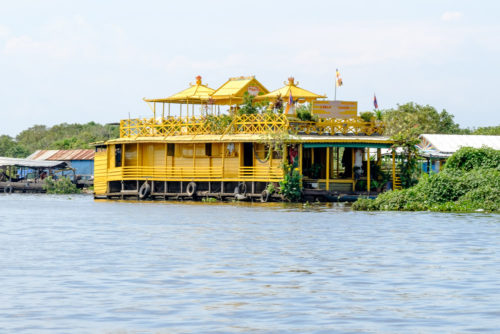

As soon as you enter the village, you’ll see rows of tourist boats docked closely together. You’ll also start smelling that fishy smell that seems to be present with river villages. One look at the water and you realize that it’s not even remotely clean. But people in the village still use it for washing and bathing.
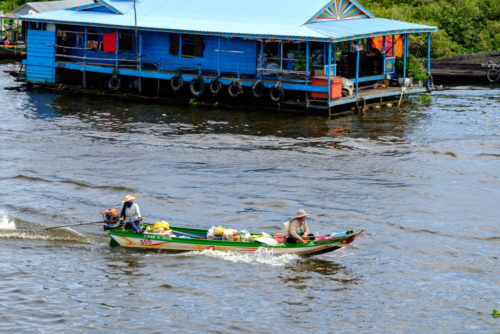
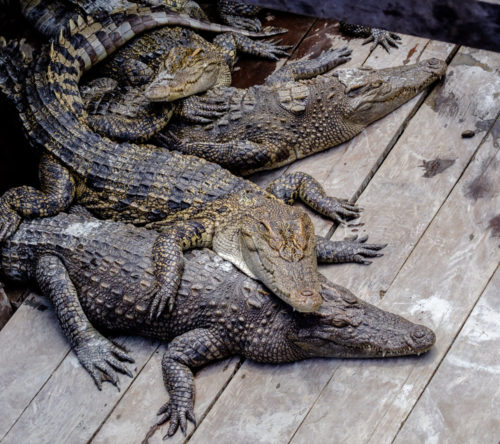
The floating village is rather small. After about 20 minutes of going slowly on the boat, you’ll reach the large Tonle Sap lake. On the way there, however, you’ll see many interesting sights. Swelling of the lake is quite evident everywhere as the temples and cemeteries constructed in ground during dry season are now inundated.
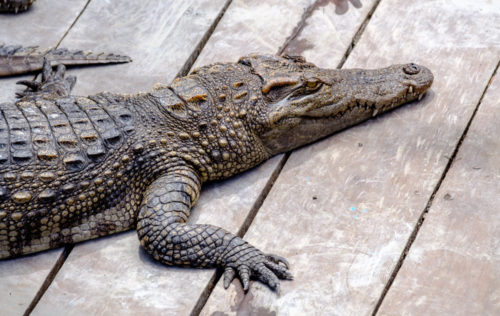
The boatman will probably point out the differing Khmer and Vietnamese floating households and the floating markets, clinics, schools. Don’t forget other boatloads of tourists, who frequent every nook and corner of the villages. Chong Khneas, while interesting, is over-touristed and is not as picturesque as I imagined of the floating villages. The trip usually includes a couple of stops – usually one a touristy floating ‘fresh water fish and crocodile exhibition’ with a souvenir and snack shop.
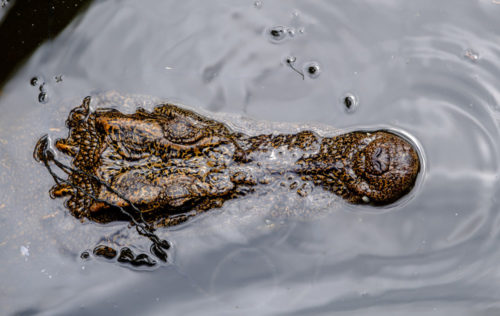
This farm is probably the ‘highlight’ of the Chong Kneas visit (other than the village and the lake itself). The fish farm is a catfish farm and visitors have the chance to feed them. When we came, the fish weren’t that excited about the food. I suppose they were already full of food thrown in by previous visitors.
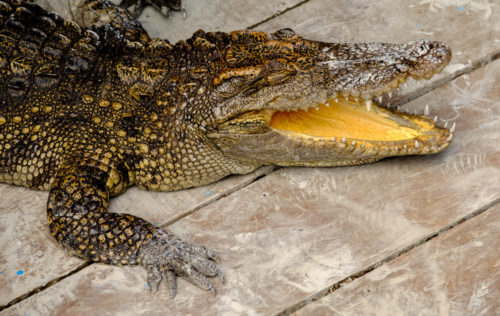
There is a crocodile farm with about twenty crocodiles right next to the fish farm. Most of them hide, but you can still see some of them clearly, whether they’re sleeping or yawning.
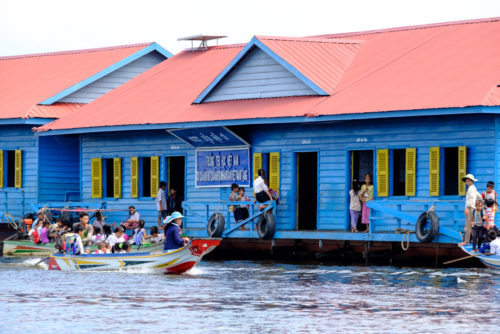
There are also catfish heads floating around the crocodile’s cage. So apparently the fish from the farm gets fed to these crocodiles. These crocodiles finally end up as purses and belts. Souvenir shop on this boat was also selling these end products.
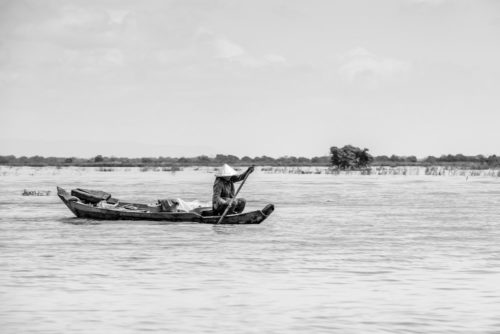
You can also go to the 2nd and 3rd story of the farm for a great view overlooking the floating village and Tonle Sap Lake.
Boatmen also try to get you to agree to stop at a school or orphanage, and to donate rice to the poor children, which I do not recommend. We politely asked the operator to skip this part of the tour. Overall it was different, but not extraordinary.
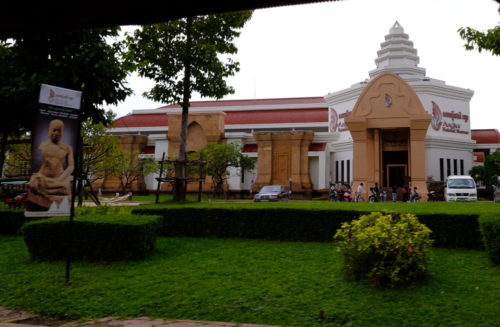
Our next destination was Angkor National Museum. The museum is located on the way between downtown Siem Reap to northern road leading to Angkor ancient city. Opened in 2007, the Angkor National Museum covers the golden era of the Khmer Empire, making use of audio-visual multimedia technology. The museum covers Khmer history, civilization, and cultural heritage in eight galleries. The museum has a strict no-photos policy. So you won’t see any photos here other than the exterior.
The museum is owned and operated by Thai Vilailuck International Holdings, based in Bangkok, so little of your admission money goes to Cambodia or to temple restoration. The exterior of the museum is a slight eyesore being made to look like a Thai structure rather than a Khmer one. But the interior is stunning with a spiral staircase taking you to the main galleries and also served as the lift for heavy stone artefacts that otherwise would not have made it to the second floor, while a reflecting pool used in official water ceremonies is a calming presence.
A visit is a comfortable, air-con alternative to visiting the temples themselves, and a nice educational supplement to the history of Angkor. I would recommend the museum to anyone who wants to visit Angkor temples as the first item in their itinerary, so they get oriented well with history of Angkor. We made the mistake of visiting it on the third day. Keep at least 2-3 hours to visit this informative museum. It’s composed of eight separate galleries, all connected by a vaulted corridor with a series of fountains and lined with what seems like all the Angkorian lion and demon heads missing from statues at the temples. After an explanatory film screening called Story behind the legend, you’re pointed toward the galleries.
1,000 Buddha Images is the only gallery that’s just one large room. Hundreds of small and miniature Buddha figurines, made of metals, jewels and wood, all individually illuminated, line the walls here, identified according to the period they were made during and where they were discovered. In the centre, life-size and larger Buddha characters are displayed. The display includes Buddhas from Banteay Kdei, Bayon, Angkor Wat and Preah Vihear. Unfortunately majority of the Buddhas images in the gallery of 1,000 Buddha allude in design to later Ayutthaya-era in Thailand and have no aesthetic link with Angkor.
Pre-Angkor Period: Khmer Civilisation gallery and all the subsequent ones combine mural-size explanations and short films through maze-like rooms explaining Angkorian history.
Religion and Beliefs room is next and it explains several of the most significant Hindu and Buddhist religious stories and folk tales depicted on Angkorian temples, including the most memorable Churning of the Sea of Milk carved into the rear wall at Angkor Wat. Carvings of Buddhist and Hindu religious figures are concentrated here as well.
The Great Khmer Kings is the 4th gallery which focuses on King Jayavarman II, Yasovarman I, Soryavarman II and Jayavarman VII, those most responsible for Angkor’s greatest constructions. Figures of the kings and relics from the temples they commissioned abound.
Angkor Wat is a large film gallery inside this section of the museum. It features beautiful, panoramic images of the temple and explanations of how it was constructed. There are also many restored figures from the temple itself as well as post-Angkorian wooden statues used for worship at the temple until several hundred years ago. It is the best place to watch sunrise behind Angkor Wat without waking up early in the morning 😉 .
Here is the YouTube video of the Angkor National Museum.
[youtube]4l0S7ACa7Rk[/youtube]
Angkor Thom is the 6th one which features recovered artefacts from Angkor Thom, this gallery includes a history of and artefacts from the vast irrigation projects commissioned by the king who built Angkor Thom with his smiling face looking out from every tower: Jayavarman VII.
Story From Stones is one of the most interesting. It’s a collection of stone pallets with ancient Khmer and Sanskrit inscriptions. The writing on each slate is explained on placards below. The writing on them includes the declaration of the construction of a new hospital, lists of slave names, mediations of land disputes and adulations of kings and gods. The alphabets are so similar to
Ancient Costume is the last gallery. From Apsaras and kings to princesses and warriors, this room contains the busts and statues of distinct fashions and styles as they evolved throughout Angkor time. There’s also a collection of ancient jewellery and headdresses. It’s a clever segue to the final room — the gift shop — where upscale imitations of these fashions abound.
It’s $12 to enter the museum, and another $3 for an educational audio headset. Sadly, like ticketing and management of the Angkor park, the museum is owned and run by a private company, so little of your admission money goes to Cambodia or to temple restoration. Still, it’s perhaps better than these artefacts remaining in the hands of private collectors.
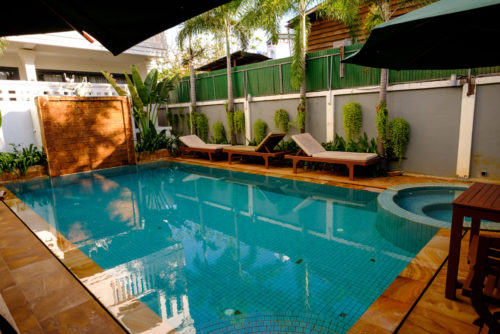
After the museum we went back to the hotel to freshen up. Later that evening was shopping session at Night market. Near Sivatha St, Siem Reap’s original night market has sprung countless copycats, but it remains the best, packed with stalls selling a variety of handicrafts, souvenirs and silks and is well worth a browse.
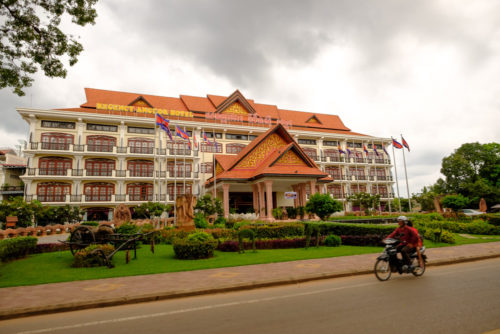
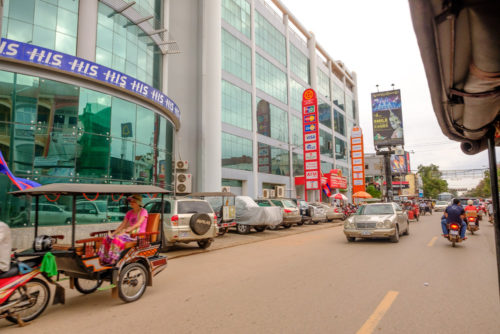
In 2007, the Angkor Night Market was set up, a few years later a second market opened, the Noon Night Market. Both are entirely geared towards tourists and as a result, almost all stalls are souvenir shops.
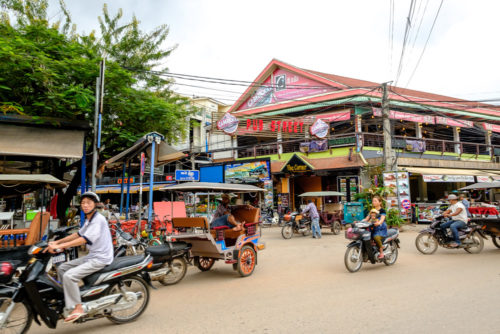
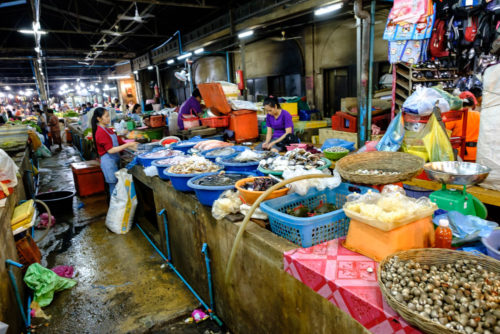
Both night markets are conveniently located a few streets away from the Old Market (open in the day) and the lively Pub Street. The night markets are good places for souvenir shopping, but of course be prepared to do some heavy bargaining. You can just about get any souvenir you want to buy in Siem Reap at this place. The variety and quality of the stuff here seems somewhat better than the old market (Psar Chas) but so is the price.
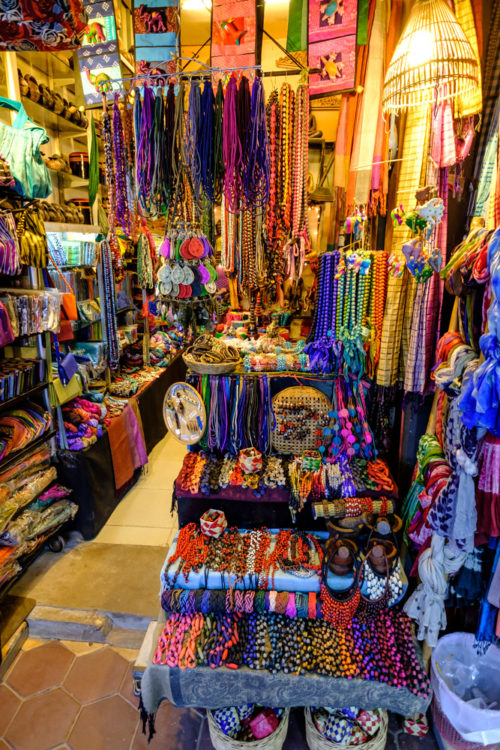
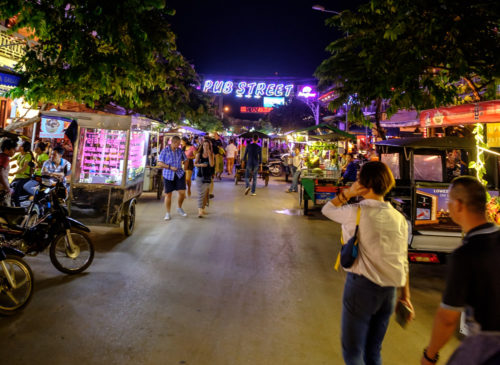
Pub Street, officially titled Street 8, is the culinary and nightlife hub of Siem Reap, sort of the city’s answer to Bangkok’s famed Khao San Road. On Pub Street, you’ll find an assortment of restaurants and bars, as well as entertaining street performers and some fantastic people watching. From 5 pm onwards, the street is blocked off to motor traffic, making it a relaxing place to stroll and take in the sights. You can’t visit Siem Reap without stopping by Pub Street at least once, and you may just love it so much you’ll make it your nightly haunt.
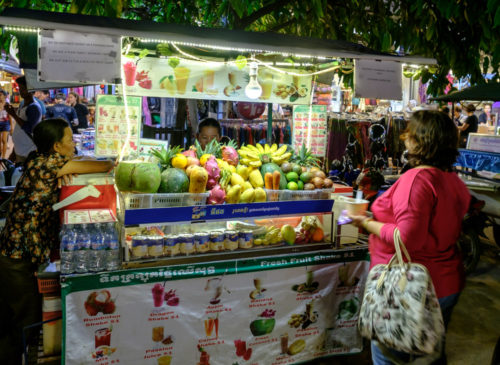
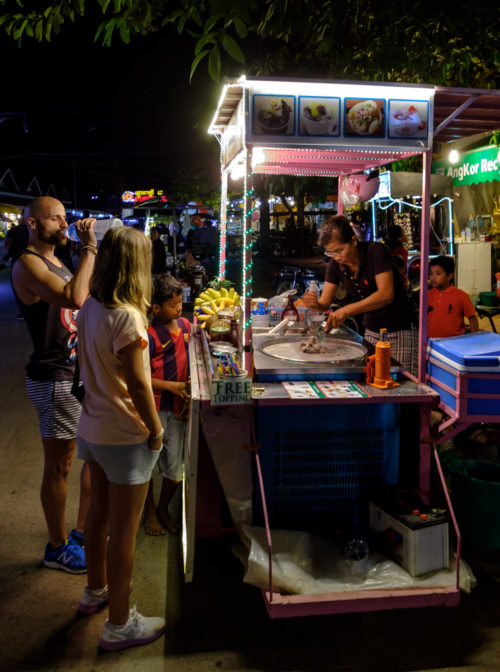
Pub Street may be known primarily for its nightlife, but it’s also a fantastic place to grab a bite to eat any time of day. Considering Pub Street is such a popular tourist destination, meals are very reasonably priced, generally ranging from about US$4 to $6.
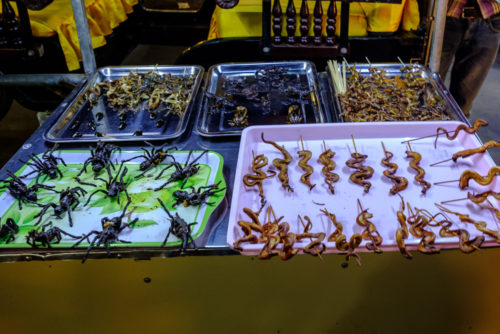
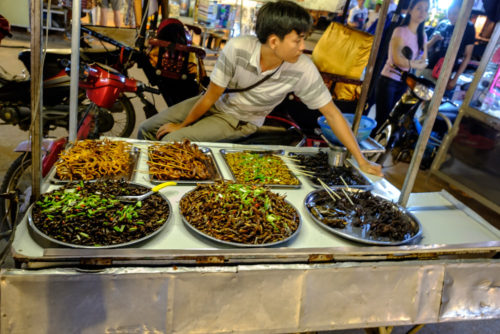
Most of the restaurants’ menus feature a mix of Western and Khmer foods, so no matter your tastes, you’ll find something that suits you. Menus are displayed in front of each restaurant, so wander the street and browse the menus to take your pick.
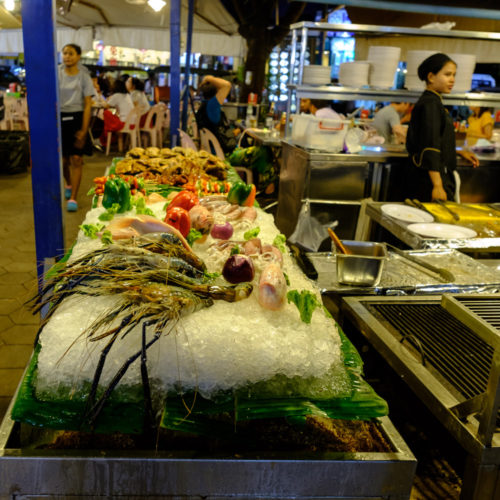
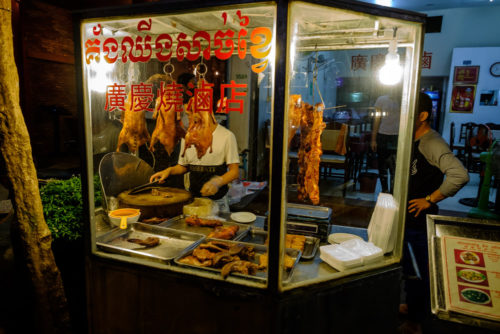
Siem Reap may be a relatively small city, but it still has a nightlife scene that’s raved about by visitors from all over the world. Pub Street, as well as its surrounding streets, is easily the best part of Siem Reap for nightlife
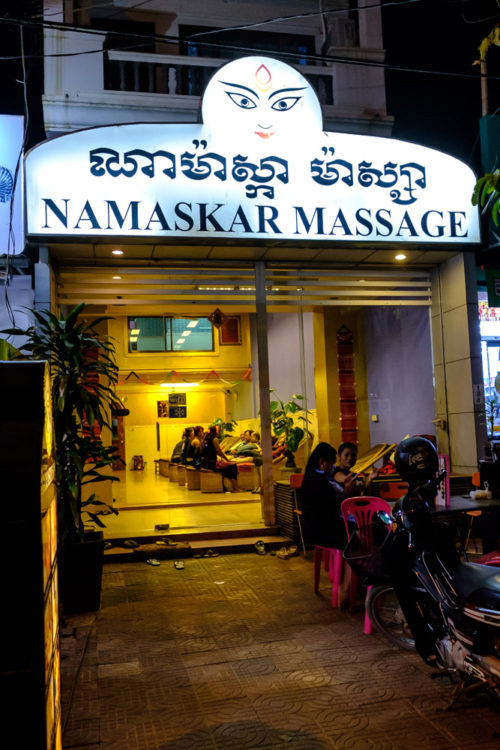
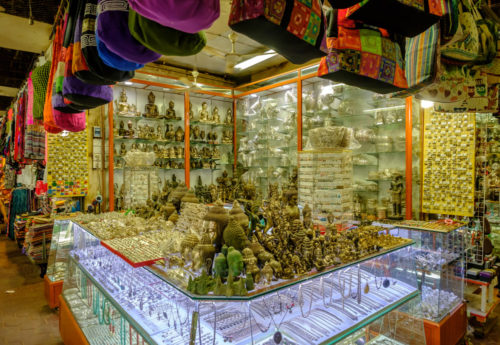
Khmer massage parlours are everywhere. From foot massage to fish massage, they give you much needed relaxation to your foot, body or soul. A fish massage is where you drop your feet in a fish tank and watch as they nip off your dead skin.
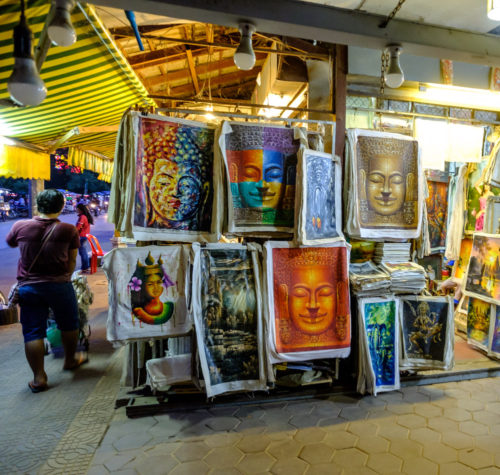
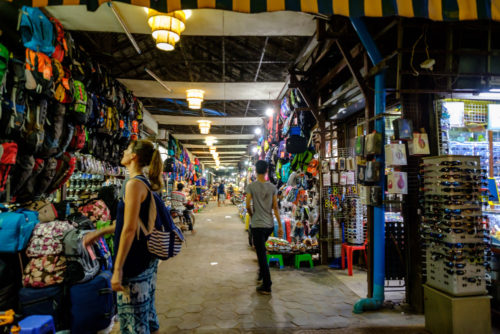
Fried ice cream is a unique ice cream. It is not fried as the name suggest, but is a roll of ice cream created in front of you from milk shake mixed with your choice of toppings like pineapple, passion fruit, mango, or Oreos.
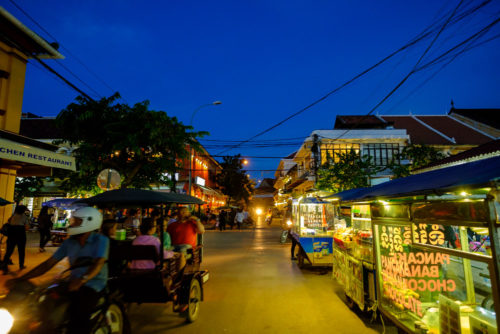
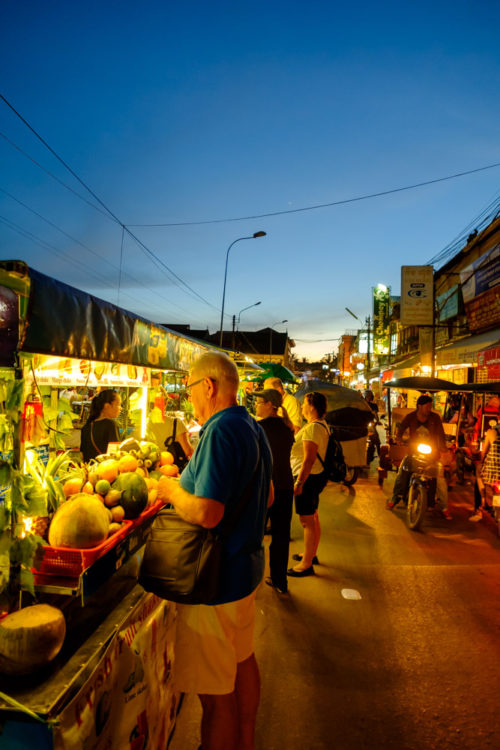
You’ll find lots of fantastic live music within Pub Street’s bars, but don’t forget to stop and have a listen to the street performers you’ll find wandering up and down the street.
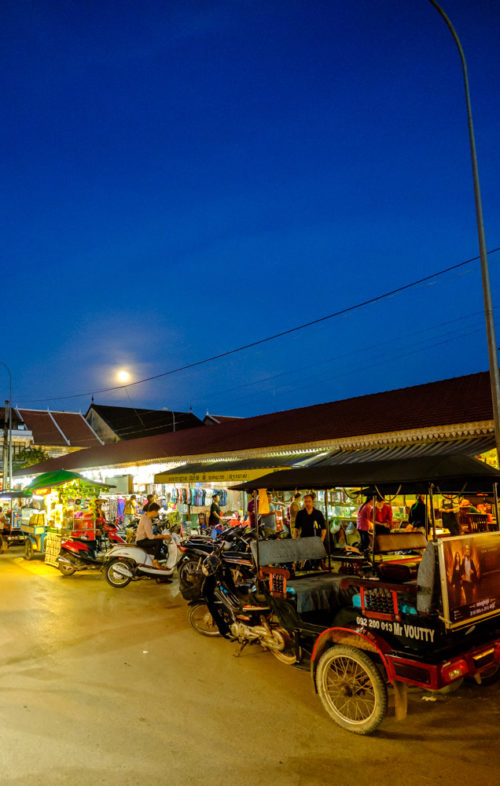
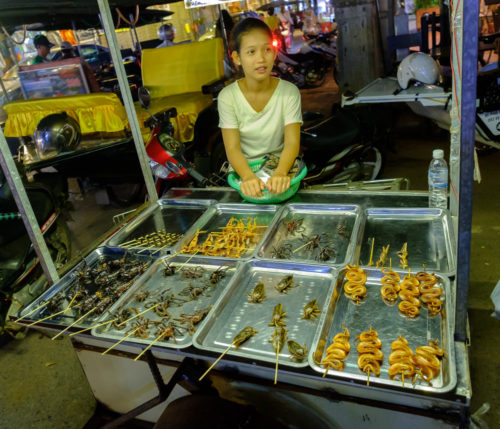
After enjoying the street food and plenty of window shopping, we returned back to our room. Next day we planned to visit Phnom Kulen mountain range and rest of the temples which we wanted to visit. That will be covered in my next blog.
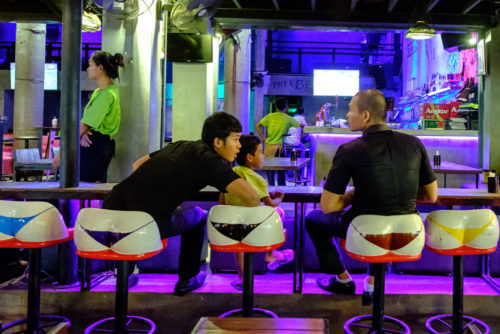
Thanks to all of you for being part of this journey and encouraging me to write this travelogue. If you have missed earlier, check all the 8 parts with links below.

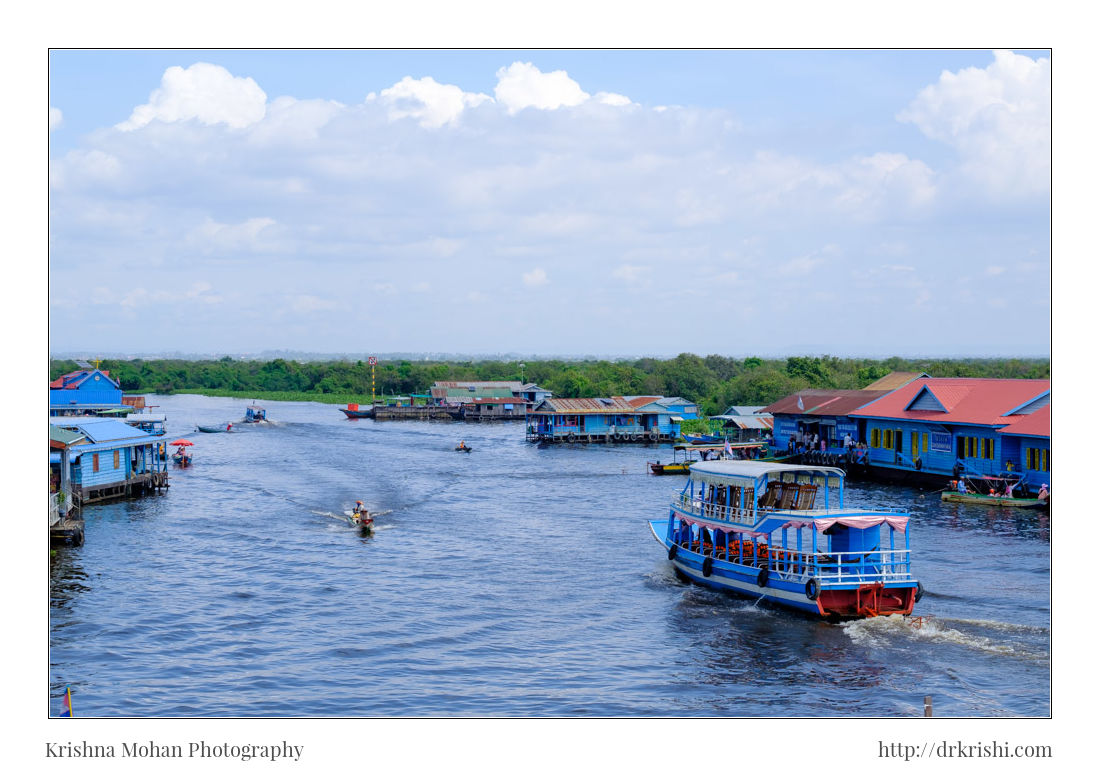
Very detailed blog. Beautiful pictures. It’s as if we are on a virtual tour of the place of the lost gods, not to forget the Apsaras